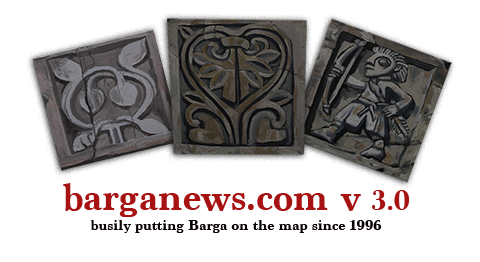This walk starts again from the space in front of Porta Mancianella and proceeds along the main road of the town, the Via di Mezzo (Halfway Street).
The name couldn’t be more appropriate as the street leads from one end of the historic part of the town to the other, cutting it almost exactly in half.
At the other end of Via di Mezzo is the other entrance to the town, the Porta Macchiaia (Gate of the Woods), so-called because it faces that part of the Barga territory which is covered in the trees and shrubs of the Appenines.
For centuries these woods provided the lumber and charcoal for the people of the town.
Via di Mezzo is also the street where you will find Barga’s most elegant squares and buildings.
After passing several tall sombre houses, which rarely see the sun, you come to a charming square, the Piazza della Santissima Annunziata.
Here you will find a beautiful Baroque church (17th-18th Cent.) which is one of the more distinguished of the Barga churches and which is well worth a visit.
Inside are several interesting works of art, including the altar painting by Baccio Ciarpi (1574-1654).
Ciarpi was originally from Barga but he worked in Rome and is well known nationally.
Also of interest is the group of wooden statues representing the Annunciation.
These statues are the work of Tuscan masters and date back to the first decades of the 14th Century.
La chiesa della Santissima Annunziata
Fu edificata nel 1595 dalle famiglie principali del luogo per custodirvi due statue lignee raffiguranti l’Annunciata e l’Angelo Annunciante, di un maestro toscano dei primi decenni del Trecento. All’esterno due coppie di paraste sorreggono l’architrave con timpano triangolare; nella lunetta sopra il portale è dipinta una Annunciazione.
All’interno, a croce latina e con cappelle laterali, due grandi pitture murali dell’Ottocento raffiguranti lo Sposalizio della Vergine e la Presentazione di Gesù al tempio del Giammattei di Lucca, autore anche della decorazione della cupola. Nel primo altare a destra, la Madonna col Bambino e i Santi Antonio Abate, Francesco e altro Santo pellegrino del pittore barghigiano Baccio Ciarpi, di inizio Seicento.
Sulla cantoria in controfacciata si trova un organo a trasmissione elettrica costruito nel 1962 da Libero Rino Pinchi, con 11 registri su unico manuale e pedale.

